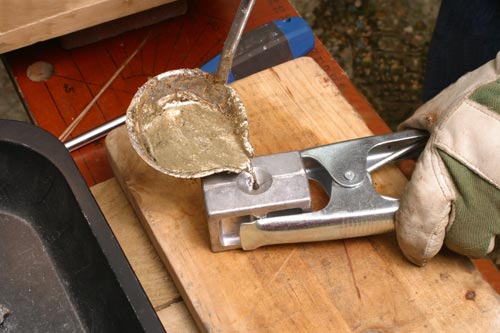Most saltwater fishermen from a boat, surf, or jetty will use some type of sinker to hold their offerings to the bottom. Some type of fisheries, primarily wreck fishing tend to use heavier sinkers due to lost gear from snags on structures.
This can get expensive, especially having to constantly buy new rigs and weights from tackle dealers. With a few nominal one-time purchases (lead melting pot, mold, ladle) you can easily make your own sinkers and fishing lures, while saving money in the longrun.
Soft Metal Options
Lead (Pb) has been used for years as the main ingredient in most jigs and sinkers, but it shouldn’t be used in freshwater applications as it will persist longer and can create some environmental issues. Tin (Sn) can be substituted and it will melt at a lower temperature (Sn – 450ºF vs. Pb 621ºF), but due to it’s lower density it will weigh considerably less for the same size sinker.
Safety Considerations
I recommend using gloves and safety glasses when melting or pouring molten lead or tin as molten metal will cause considerable damage. Glasses or goggles are an absolute necessity as molten metal can be easily splashed and you only have one shot with your eyes.
RELATED:
Proper ventilation is another careful consideration to prevent the inhalation of any potentially harmful fumes. Finally, proper hand protection should be considered when mixing or pouring liquid metal. Although making your own lures presents some danger, by playing it safe, it can be accomplished with relatively no issues.
Materials to Get You Started
Melting pots can be easily purchased from a variety of tackle suppliers or tackle shops, while meltable metals can be obtained from scrap metal facilities. If using lead, I highly recommend soft lead compared to the “hard-alloy based” lead used in wheel weights.
It is a good idea to mention or request soft lead from your local scrap yard, generally they will be more than willing to accommodate you. When melting any soft metal, be sure to perform the melting and pouring with adequate air ventilation. I recommend setting up some sort of fan to blow away any fumes that may be released in the melting process. Once the material becomes an easily poured liquid, it is time to pour into the molds.
DO-IT Molds are one of the largest makers of aluminum molds for lures, sinkers, and accessories. I will pour in each mold cavity 1 to 2 times to “warm” up the mold, and then will start pouring for the lures or sinkers. By warming up the mold, it helps the metal flow easier into the cavity. DO-IT brand molds have wood handles, so if they start to smoke than you know you’re pouring too fast and should take a little time in between to allow the mold to cool so it doesn’t warp.
As a northeast charter captain, I use a large quantity of sinkers and lures varying from 1/2oz to 8 oz and generally will lose a few especially when fishing heavily structured areas. When I’m off the water, such as the winter months, I utilize the time by making tackle for the following season. So the next time you have some “down time” during your off-fishing-season, spend some time prepping as you will save some money in the long run.
Photo credit: Surf casting sinkers








